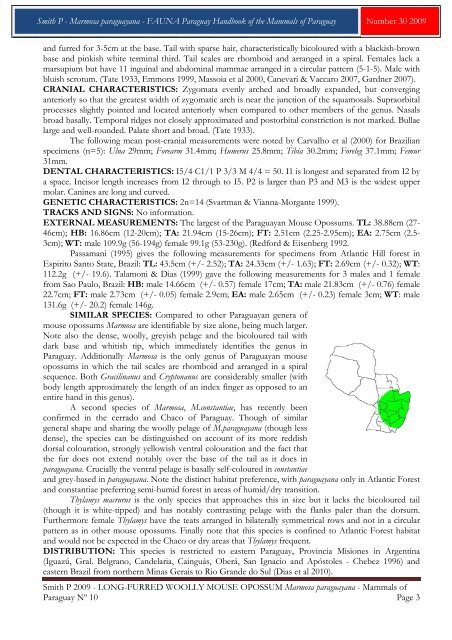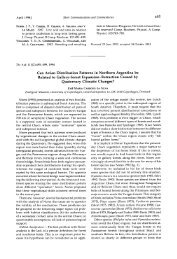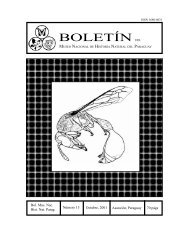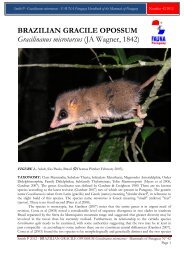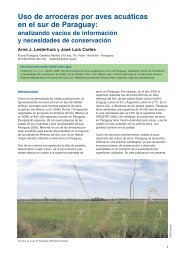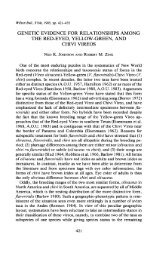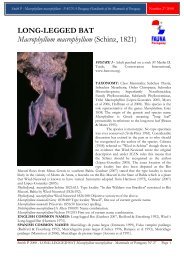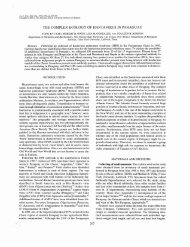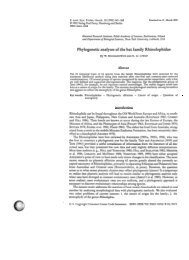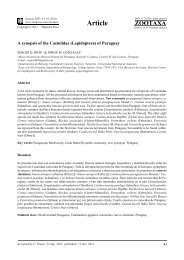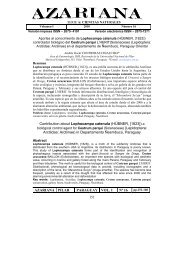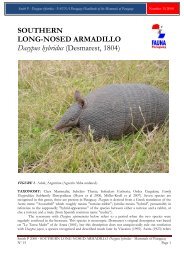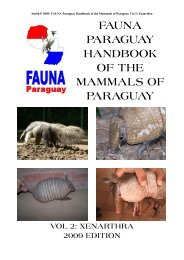Smith P 2009 - FAUNA Paraguay
Smith P 2009 - FAUNA Paraguay
Smith P 2009 - FAUNA Paraguay
Create successful ePaper yourself
Turn your PDF publications into a flip-book with our unique Google optimized e-Paper software.
<strong>Smith</strong> P - Marmosa paraguayana - <strong>FAUNA</strong> <strong>Paraguay</strong> Handbook of the Mammals of <strong>Paraguay</strong> Number 30 <strong>2009</strong><br />
and furred for 3-5cm at the base. Tail with sparse hair, characteristically bicoloured with a blackish-brown<br />
base and pinkish white terminal third. Tail scales are rhomboid and arranged in a spiral. Females lack a<br />
marsupium but have 11 inguinal and abdominal mammae arranged in a circular pattern (5-1-5). Male with<br />
bluish scrotum. (Tate 1933, Emmons 1999, Massoia et al 2000, Canevari & Vaccaro 2007, Gardner 2007).<br />
CRANIAL CHARACTERISTICS: Zygomata evenly arched and broadly expanded, but converging<br />
anteriorly so that the greatest width of zygomatic arch is near the junction of the squamosals. Supraorbital<br />
processes slightly pointed and located anteriorly when compared to other members of the genus. Nasals<br />
broad basally. Temporal ridges not closely approximated and postorbital constriction is not marked. Bullae<br />
large and well-rounded. Palate short and broad. (Tate 1933).<br />
The following mean post-cranial measurements were noted by Carvalho et al (2000) for Brazilian<br />
specimens (n=5): Ulna 29mm; Forearm 31.4mm; Humerus 25.8mm; Tibia 30.2mm; Foreleg 37.1mm; Femur<br />
31mm.<br />
DENTAL CHARACTERISTICS: I5/4 C1/1 P 3/3 M 4/4 = 50. I1 is longest and separated from I2 by<br />
a space. Incisor length increases from I2 through to I5. P2 is larger than P3 and M3 is the widest upper<br />
molar. Canines are long and curved.<br />
GENETIC CHARACTERISTICS: 2n=14 (Svartman & Vianna-Morgante 1999).<br />
TRACKS AND SIGNS: No information.<br />
EXTERNAL MEASUREMENTS: The largest of the <strong>Paraguay</strong>an Mouse Opossums. TL: 38.88cm (27-<br />
46cm); HB: 16.86cm (12-20cm); TA: 21.94cm (15-26cm); FT: 2.51cm (2.25-2.95cm); EA: 2.75cm (2.5-<br />
3cm); WT: male 109.9g (56-194g) female 99.1g (53-230g). (Redford & Eisenberg 1992.<br />
Passamani (1995) gives the following measurements for specimens from Atlantic Hill forest in<br />
Espirito Santo State, Brazil: TL: 43.5cm (+/- 2.52); TA: 24.33cm (+/- 1.63); FT: 2.69cm (+/- 0.32); WT:<br />
112.2g (+/- 19.6). Talamoni & Dias (1999) gave the following measurements for 3 males and 1 female<br />
from Sao Paulo, Brazil: HB: male 14.66cm (+/- 0.57) female 17cm; TA: male 21.83cm (+/- 0.76) female<br />
22.7cm; FT: male 2.73cm (+/- 0.05) female 2.9cm; EA: male 2.65cm (+/- 0.23) female 3cm; WT: male<br />
131.6g (+/- 20.2) female 146g.<br />
SIMILAR SPECIES: Compared to other <strong>Paraguay</strong>an genera of<br />
mouse opossums Marmosa are identifiable by size alone, being much larger.<br />
Note also the dense, woolly, greyish pelage and the bicoloured tail with<br />
dark base and whitish tip, which immediately identifies the genus in<br />
<strong>Paraguay</strong>. Additionally Marmosa is the only genus of <strong>Paraguay</strong>an mouse<br />
opossums in which the tail scales are rhomboid and arranged in a spiral<br />
sequence. Both Gracilinanus and Cryptonanus are considerably smaller (with<br />
body length approximately the length of an index finger as opposed to an<br />
entire hand in this genus).<br />
A second species of Marmosa, M.constantiae, has recently been<br />
confirmed in the cerrado and Chaco of <strong>Paraguay</strong>. Though of similar<br />
general shape and sharing the woolly pelage of M.paraguayana (though less<br />
dense), the species can be distinguished on account of its more reddish<br />
dorsal colouration, strongly yellowish ventral colouration and the fact that<br />
the fur does not extend notably over the base of the tail as it does in<br />
paraguayana. Crucially the ventral pelage is basally self-coloured in constantiae<br />
and grey-based in paraguayana. Note the distinct habitat preference, with paraguayana only in Atlantic Forest<br />
and constantiae preferring semi-humid forest in areas of humid/dry transition.<br />
Thylamys macrurus is the only species that approaches this in size but it lacks the bicoloured tail<br />
(though it is white-tipped) and has notably contrasting pelage with the flanks paler than the dorsum.<br />
Furthermore female Thylamys have the teats arranged in bilaterally symmetrical rows and not in a circular<br />
pattern as in other mouse opossums. Finally note that this species is confined to Atlantic Forest habitat<br />
and would not be expected in the Chaco or dry areas that Thylamys frequent.<br />
DISTRIBUTION: This species is restricted to eastern <strong>Paraguay</strong>, Provincia Misiones in Argentina<br />
(Iguazú, Gral. Belgrano, Candelaria, Cainguás, Oberá, San Ignacio and Apóstoles - Chebez 1996) and<br />
eastern Brazil from northern Minas Gerais to Rio Grande do Sul (Dias et al 2010).<br />
<strong>Smith</strong> P <strong>2009</strong> - LONG-FURRED WOOLLY MOUSE OPOSSUM Marmosa paraguayana - Mammals of<br />
<strong>Paraguay</strong> Nº 10 Page 3


